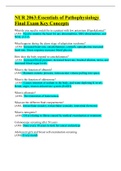NUR 2063:Essentials of Pathophysiology
Final Exam Key Concepts
What do you need to watch for in a patient with low potassium (Hypokalemia)?
(ANS- Need to monitor the heart for any abnormalities, EKG abnormalities, and
WNL (3.5-5)
What happens during the alarm stage of adaptation syndrome?
(ANS- Increased heart rate, catecholamines, cortisols, epinepherine increased
heart rate. Stress response increases blood glucose.
How does the body respond to catecholamines?
(ANS- Increased blood pressure, increased heart rate, brachial dilation, stress, and
increased blood sugar levels.
What is the function of albumin?
(ANS- Maintain osmotic pressure, intravascular volume pulling into space.
What is the function of aldosterone?
(ANS- Causes retention of sodium in the body, and water depleting K levels.
Renin, angio, tension aldosterone system (RASH)
What is allostasis?
(ANS- The restoration of homeostasis.
What are the different fluid compartments?
(ANS- Intracellular (inside), extracellular (outside), interstitial (between)
What is iatrogenic?
(ANS- Of or relating to illness caused by medical examination or treatment.
Colonoscopy screening after 50 years
(ANS- Done every 10 years to look for cancer and polyps
Adolescent girls and breast self-examination screening
(ANS- Every month
,Primary function of bone marrow
(ANS- To produce RBC, WBC, platelets. Hematopoiesis
Assessment findings with localized inflammation
(ANS- Heart, swelling, redness, and pain
Leukocytosis means
(ANS- Increased number of WBC in the body
What is leukemia?
(ANS- Abnormal production of WBC/proliferation. (4k-11k)
Define cachexia
(ANS- Weakness associated with cancer/chronic illness, weight loss and muscle
loss
What happens with gout?
(ANS- Abnormal uric acid metabolism, and crystals.
What are collagen fibers?
(ANS- Scar formation after healing.
What process results in osteoporosis?
(ANS- Imbalance of bone re-absorption and bone formation.
What does purulent exudate and serous exudate mean?
(ANS- Serous transparent (blister) pale yellow. Purulent pus (WBC and bacteria)
Priority assessment with myasthenia crisis
(ANS- Affects muscle paralysis of respiratory muscles, possible respiratory attack,
check respiration, check ventilation
Complication with compartment syndrome
(ANS- tissue damage/pain, possible necrosis, hypoxia, 5 P's
Stress and peptic ulcer relation
(ANS- Too much stress=decreased blood flow to the stomach, develops ulcers. (H.
pylori)
, Cause of Hirschsprung's disease
(ANS- Develops improper colon, innervation of the colon/large intestine.
Autonomic ganglia are reduced or absent.
Function of parietal cells of gastric mucosa
(ANS- Vitamin B12 secreted by preital (gastric mucosa production), intrinsic
factor
Frequent location of peptic ulcer
(ANS- Duodenum/stomach
What is occult blood?
(ANS- Blood in stool, test general testing
Kidneys
(ANS- The slope of nephrons
What is the anabolic process?
(ANS- Catabolism=broken down into simple structures
Anabolic=building complex structures
Genetic defect associated with cystitis
(ANS- Back flow of urine vesicoureteral reflux, causes inflammation, bladder
inflammation
pyelonephritis-infection of the kidneys
nephritis-inflammation of the kidneys
Hormone associated with dysfunctional uterine bleeding
(ANS- Menstruation is estrogen, pre progesterone
Causes of pyelonephritis
(ANS- Infection from E. coli (wipe from front to back)
Symptoms with BPH (benign prostatic hyperplasia)
(ANS- Difficult urination, oliguria (low urine output), dribbling
When is the Renin-angiotensin system activated?
(ANS- Regulates BP, fluids, and electrolytes. Release Renin, aldosterone system,
acute kidney injuries, low BP, and nephron.




